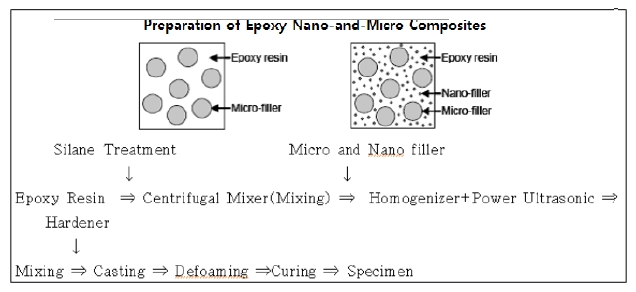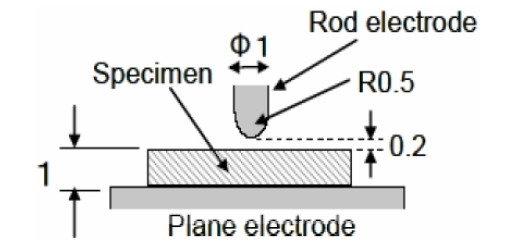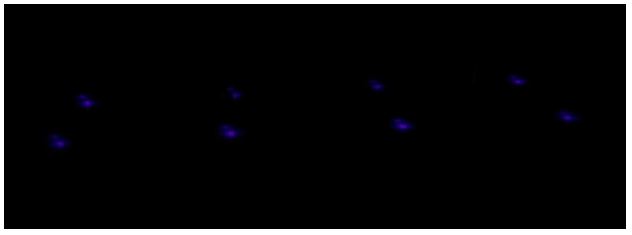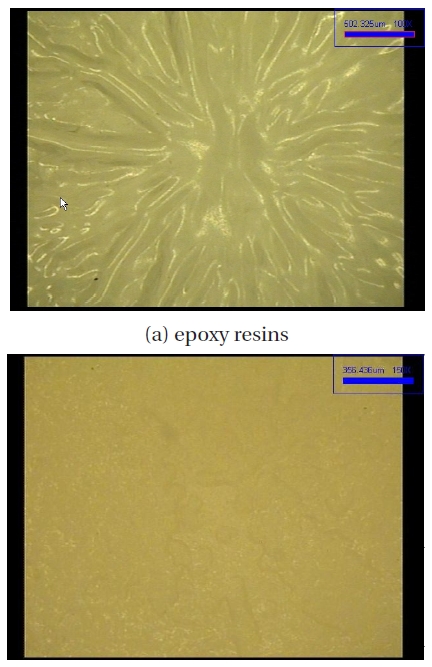



Surface erosions that cause partial discharges (PDs) in a polyamide sample filled by nano fillers at 2-5 wt?% were shown to be much smaller than that of the micro composites filled by original epoxy resins and micro fillers. The PD resistance in the polyamide nano composites represented larger levels than that found in the polyamide filled by micro fillers and the original polyamide [1-3].
In addition, these nano effects can be considered to have an action that resists the PD deterioration that includes the coupling between the fillers and matrices, the spaces between the fillers, and the morphological mesoscopic interactions. Authors in other studies have reported that the PD resistances can be significantly improved by adding a small amount of nano fillers into the epoxies TiO2 [4] and boehmite Al2O3 [5]. This study measured the PD resistance that causes the surface erosion by fabricating three different composite samples: original epoxy resins, micro composites with and without the silane processing, and nano and micro mixture composites.
2.1 The preparation of the nano-and-micro mixture composites
As illustrated in Fig. 1, the epoxy resin that includes the epoxy nano-and-micro mixture composites (ENMCs) preparation with micro scaled SiO2 fillers was fabricated based on the conventional insulation materials.
The SiO2 fillers, with the average diameter of 3 μm, were dispersed into the epoxy resins. The total amount of micro fillers was 50 phr. The epoxy resin and hardener containing the micro fillers were mixed according to the chemical equivalent weight of hardening reactions. The mixtures were injected into a mold and then a vacuum deforming process was applied. The specimen of the epoxy that includes micro fillers was obtained through the first and second hardening processes at 120℃ × 2 hr + 150℃ × 24 hr. In the case of the dispersion of the mixture composites with nano and micro particles, the fabrication process of the epoxy resin, which includes nano particles (SiO2_10 nm) and micro particles (SiO2_3 μm), can be seen in Fig. 1. The SiO2 nano particles are a type of fumed SiO2 made as a spherical filler with an average diameter of about 10 nm. The nano and micro particles were dispersed to the epoxy resins through ultrasonic waves and a homogenizer, and were also mixed by adding a hardener while using a centrifuge [6,7]. The filling ratio of the micro particles can be varied according to the filling content ratio of the nano fillers. This study investigated the PD resistance for the micro composites (50 phr) with and without the silane processing and the nano- and micro mixture composites (nano particle filling content: 1 phr). Table 1 shows the detailed compositions.
[Table 1.] The composition ratio for the ENMC.

The composition ratio for the ENMC.
2.2 The PD resistance electrodes and the experiment
As illustrated in Fig. 2, the rod electrode used to measure the PD resistance was configured by the 0.2 mm gap between the upper and the lower plane tungsten electrodes with a curvature radius of 5 mm. The light emitted from the PD was generated from the air gap of the rod-plane electrode system in an evaluation process of the PD resistance. Figure 3 shows a temporal change in the light emission of the PD. For the measurement of PDs, this study developed an electrode device for the PD resistance that is able to measure eight different samples at the same time and measured the resistance based on the same four types of samples. As introduced in the results of the study performed by Toshikatsu Tanaka [6], it can be seen that the light emitted from the PD did not depend on the deterioration time. The PDs done at the end of the rod electrode for the initial period (0 hr) were generated through the entire regions, with the end of the electrode changing to a black color under the application voltage of 6 kVrms after 96 hours. This is due to the surface adhesion of the epoxy resins from the oxidation caused by the discharge in the air and the evaporation from the epoxy resin. The adhesion of the metal oxides and insulation materials on the surface of the electrode may suppress a PD.
[Table 2.] The depth of the surface erosion.
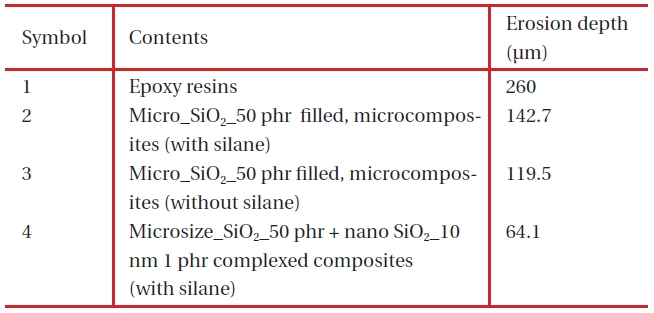
The depth of the surface erosion.
2.3 The surface erosion depth of the PD resistance
As shown in Fig. 4, this study applied some experiments using the nano and micro particle mixture composites in which the conventional micro SiO2 particles, filled by 50 phr, and the nano particles (SiO2_10 nm), filled by 1 phr, and the original epoxy resin were used under the same conditions (AC 6 kVrms and 720 Hz for 96 hours). The erosion surfaces of the nano and micro mixture composites and the original epoxy resin represent totally different patterns. The original epoxy resin shows severe uneven erosions at the surface of the sample. In addition, in the case of the nano composites that represent significant cohesions, the particles are easily separated due to the PD. However, in the case of the homogeneous dispersion, there is an increase in the resistance due to the fact that the dispersion makes it difficult to erode. The maximum erosion depth of the nano and micro mixture composite materials was measured to be 64.1 μm. Compared to the 260 μm depth of the original epoxy resin, the erosion rate is delayed by 304%. In the study performed by Kozako et al. [2], the PD resistance of the polyamides nano composites that have the nano composite layered silicates represented more improvement than that of the original polyamides resins. In the study performed by Tanaka et al. [8], the epoxy resin improved the PD resistance with the insertion of nano fillers; that showed similar results to this study. In the property of the PD according to the size of the silica fillers, the relationship between the resistance of the PD that shows an increase in its level according to the decrease in the size of silica fillers and the size of particles can be determined to have an inverse proportion. It has also been reported that the silane coupling increases the PD resistance at a certain level [8]. In this study, the mixture of the nano samples with the silane processing and the micro particles that represented the stable PDs, where the micro and nano particles that include 1 phr of nano particles based on its homogeneous dispersion, represent a stable structure with a dense internal structure through the penetration the smaller particles into the gaps between the 50 phr micro particles. Because the structure has a stronger composition that increases the PD resistance significantly due to the interfacial strengthening between the silica, which is a type of nano particle, and the organic polymer through the silane coupling, and the reduction in the mobility of the polymers, there is a large improvement in the PD resistance. Thus, it is clear that the nano and micro mixture composites represent better properties in the PD resistance compared to those of the original epoxy resin. In the study of Tanaka et al. [8,9], the mixture composites of nano and micro fillers represented much better PD resistances than that of the single nano composites or micro composites. This study also indicated that the improved properties introduced by several researchers showed agreement with the results obtained in this study. It can also be regarded that it makes it possible to produce some heavy power apparatuses that have excellent performances in mold insulation used in such apparatuses. There is no doubt that if the proper mixture between the nano and micro particles is achieved, it will overcome the thermal expansion coefficient [10] determined by the conventional nano particles. In addition, if the nano particles fill between the micro particles, the mobility will be largely decreased due to the decrease in the volume of the epoxy resins. This will result in improved performance.
This study fabricated conventional epoxy micro composites and nano and micro particle mixture composites (ENMC) based on the original epoxy resin in order to study their PD resistance.
Using electrodes for measuring the PD resistance and for its measurement system, the experiments were applied under the conditions of AC 6 kVrms, 750 Hz, for 96 hours. The conclusions can be summarized as follows:
The depths of the surface erosion were measured using a surface profiler.
As the original epoxy resin was determined to be the base material, the nano and micro mixture composites the resistance property that suppresses the depths of surface erosions as much as 305%.
It was difficult to expect some improvements in the PD resistance for the silane processing of epoxy-micro composites. It represented similar properties found by other researchers.
In the case of the nano composites, the difference in the PD resistance of the nano composites represented a large level for homogeneous dispersion and cohesion
